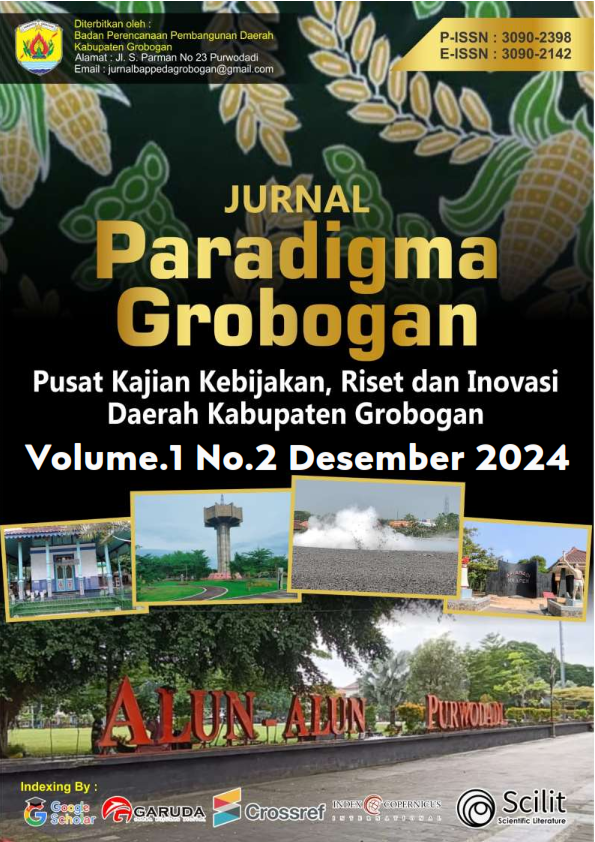Analisis Determinan Angka Kematian Ibu dan Strategi Peningkatan Kesehatan Maternal di Kabupaten Grobogan
DOI:
https://doi.org/10.58684/paradigma.v2i1.53Keywords:
Maternal mortality, maternal health, referral system, Grobogan, determinants of MMRAbstract
Maternal mortality ratio (MMR) remains a crucial indicator reflecting the quality of maternal health services in Grobogan Regency. This study aimed to analyze the main determinants of high MMR, identify gaps in the capacity of maternal health services, and describe efforts undertaken to address the issue. The research employed a descriptive qualitative design with a case study approach, involving in-depth interviews, focus group discussions, health facility observations, and a review of official documents. The findings revealed that direct causes of maternal death included postpartum hemorrhage, hypertensive disorders of pregnancy, and puerperal infection, while indirect causes were related to poor maternal nutritional status, delays in decision-making, and limited transportation access. Capacity gaps were identified in the competencies of health workers, availability of service infrastructure, suboptimal referral systems, and community behaviors favoring traditional home births. Efforts to address these issues encompassed the provision of village ambulances, midwife training, reproductive health education, and strengthening referral coordination. The study recommends more integrated interventions, including the enhancement of obstetric referral systems, improvement of transport infrastructure, increased reproductive health literacy, and multisector collaboration to accelerate the reduction of maternal mortality.
References
Badan Pusat Statistik Grobogan. (2023). Profil Kesehatan Kabupaten Grobogan Tahun 2023. Grobogan: BPS Grobogan.
Campbell, O. M., & Graham, W. J. (2006). Strategies for reducing maternal mortality: getting on with what works. The Lancet, 368(9543), 1284–1299. https://doi.org/10.1016/S0140-6736(06)69381-1
Conlon, C. M., Serbanescu, F., Marum, L. H., et al. (2019). Saving Mothers, Giving Life: It Takes a System to Save a Life. Global Health: Science and Practice, 7(Supplement 1), S6–S26. https://doi.org/10.9745/GHSP-D-18-00429
Dinas Kesehatan Kabupaten Grobogan. (2023). Laporan Tahunan Program Kesehatan Ibu dan Anak. Grobogan: Dinas Kesehatan.
Gabrysch, S., & Campbell, O. M. R. (2009). Still too far to walk: literature review of the determinants of delivery service use. BMC Pregnancy and Childbirth, 9(1), 34. https://doi.org/10.1186/1471-2393-9-34
Huda, T. M., Chowdhury, M., El Arifeen, S., et al. (2019). Distance matters: barriers to maternal and newborn care in a district of Bangladesh. BMC Pregnancy and Childbirth, 19(1), 64. https://doi.org/10.1186/s12884-019-2201-7
Kementerian Kesehatan Republik Indonesia. (2016). Pedoman Pelayanan Obstetri dan Neonatal Emergensi Komprehensif (PONEK). Jakarta: Kemenkes RI.
Kementerian Kesehatan Republik Indonesia. (2021). Profil Kesehatan Indonesia. Jakarta: Kemenkes RI.
Koblinsky, M., Matthews, Z., Hussein, J., et al. (2006). Going to scale with professional skilled care. The Lancet, 368(9544), 1377–1386. https://doi.org/10.1016/S0140-6736(06)69382-3
Lalonde, M. (1974). A New Perspective on the Health of Canadians. Ottawa: Government of Canada.
Moucheraud, C., MacDonald, P. D., & Bossert, T. J. (2015). Service readiness and availability of emergency obstetric and newborn care in Tanzania. International Journal of Health Policy and Management, 4(4), 243–252. https://doi.org/10.15171/ijhpm.2015.41
Murray, C. J. L., & Lopez, A. D. (1998). Mortality by cause for eight regions of the world: Global Burden of Disease Study. The Lancet, 349(9061), 1269–1276. https://doi.org/10.1016/S0140-6736(96)07493-4
Nair, M., Ariana, P., & Webster, P. (2012). Impact of health programmes on maternal mortality in India: a systematic review. Journal of Global Health, 2(1), 010404. https://doi.org/10.7189/jogh.02.010404
Prata, N., Passano, P., Sreenivas, A., & Gerdts, C. E. (2010). Maternal mortality in developing countries: challenges in scaling-up priority interventions. Women’s Health, 6(2), 311–327. https://doi.org/10.2217/whe.10.8
Say, L., Chou, D., Gemmill, A., et al. (2014). Global causes of maternal death: a WHO systematic analysis. The Lancet Global Health, 2(6), e323–e333. https://doi.org/10.1016/S2214-109X(14)70227-X
Thaddeus, S., & Maine, D. (1994). Too far to walk: maternal mortality in context. Social Science & Medicine, 38(8), 1091–1110. https://doi.org/10.1016/0277-9536(94)90226-7
Titaley, C. R., Dibley, M. J., & Roberts, C. L. (2010). Factors associated with non-utilisation of postnatal care services in Indonesia. Journal of Epidemiology and Community Health, 64(10), 827–831. https://doi.org/10.1136/jech.2008.081604
Victora, C. G., et al. (2012). Maternal and child health in Brazil: progress and challenges. The Lancet, 377(9780), 1863–1876. https://doi.org/10.1016/S0140-6736(11)60138-4
World Bank. (2020). World Development Indicators: Health Systems. Washington DC: The World Bank.
World Health Organization. (2015). Strategies toward ending preventable maternal mortality (EPMM). Geneva: WHO.
World Health Organization. (2019). Trends in Maternal Mortality 2000–2017. Geneva: WHO.
World Health Organization. (2021). Maternal Mortality. Retrieved from https://www.who.int/news-room/fact-sheets/detail/maternal-mortality
Yamin, A. E., & Boulanger, V. M. (2014). Why global goals and indicators matter: the experience of sexual and reproductive health and rights in the Millennium Development Goals. Journal of Human Development and Capabilities, 15(2–3), 218–231. https://doi.org/10.1080/19452829.2014.896322
Yigzaw, T., Ayalew, F., Kim, Y. M., et al. (2015). How well does pre-service education prepare midwives for practice? Competence assessment of midwifery students at graduation in Ethiopia. BMC Medical Education, 15(1), 130. https://doi.org/10.1186/s12909-015-0410-6
Zureick-Brown, S., Newby, H., Chou, D., et al. (2013). Understanding global trends in maternal mortality. International Perspectives on Sexual and Reproductive Health, 39(1), 32–41. https://doi.org/10.1363/3903213





